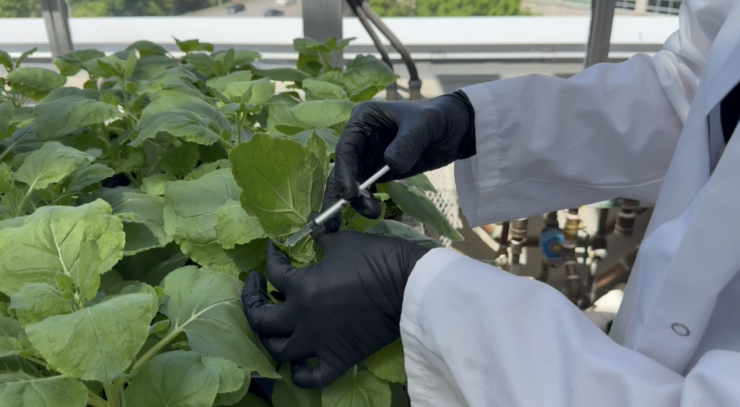FISH ARE STRESSED TOO
When two juvenile rainbow trout are paired together in a tank, typically the one fish will become chronically stressed. According to Carol Best, who is completing her PhD with Dr. Kathleen Gilmour at the University of Ottawa, rainbow trout pairing provides an ideal model to measure protein and glucose metabolism as well as the stress response itself.
The collaborative effort between the lead author, Roxanne Saulnier and Best allowed them to study how chronic social stress alters protein metabolism in juvenile rainbow trout, Oncorhynchus mykiss.
What makes rainbow trout ideal for this study?
Although zebrafish are widely known as a model species and thus, the centre of countless research. Rainbow trout are best suited for this research because they are larger and are often raised in aquaculture scenarios, meaning, the culture that breeds, rears, and harvests fish, shellfish, and aquatic plants.
Their size, explained Best, is similar to those of small lab rats. This allowed researchers to inject the necessary markers to observe protein synthesis and degradation. As mentioned, trout are often bred in aquafarms, and as such, this research can help inform that industry about best practices.
What types of stress are rainbow trout experiencing and how do they respond?
Some fish form social hierarchies, which are essentially the ranking of members within a group. Similarly, paired rainbow trout demonstrate linear dominance hierarchies.
“When they form their hierarchy one fish will become dominant and [the other] subordinate. We know that size is a factor that predisposes fish to become dominant or not, if you have a much bigger fish, they will tend to become dominant, but there are also more subtle factors,” added Best.
Best and Saulnier found that the more dominant fish monopolized most of the resources by simply eating most or all of the food provided. Now consider territory as a resource. Dominant fish took up more space in the tank and were even seen patrolling while the subordinates sat quietly on the bottom. They even showed aggression towards the subordinate fish by biting at their tails to remind them who’s in charge. As a result, the main stressor for these smaller fish is the presence of the dominant fish.
It’s important to note that “the hierarchies that we see in the lab tend to be stronger than what happens in the wild because, in the wild, they can always swim away. It’s still present, but in the lab, we control it. And so that’s an important distinction from the wild.”
Research methods
In this study, they looked at the role of cortisol, which is known as a key stress hormone. It has many functions within the bodies of fish and humans, such as regulating stress, metabolic, inflammatory, and immune system responses. The idea amongst most animals is the same, however, where the levels of the stress hormone increase as an animal experiences a stressor. This redistributes energy to the animal’s body to help them cope with that stress. Once the animal’s stressor has been dealt with, the cortisol levels should come back down to normal.
Additionally, subordinate fish stress, mainly caused by dominant fish, have a much slower growth rate simply because they’re subordinate. A good way to measure growth rate, since most of a fish’s body mass is muscle, would be to look at protein synthesis and degradation.
To begin, the fish were categorized and matched by size, and scientists measured their weight and length. Now, to establish a hierarchy, the previously sized matched fish were all allowed to interact with each other within the tank. Best and Saulnier was then able to observe the fish twice a day, by offering food pellets and she was able to identify any aggressive behaviour, fin damage, and position within the tank.
“With all of those scores, we do principal components analysis and coalesce that into one final score. The dominant fish will have the highest score and the subordinate will have the lower score. And then we start the recovery period, which lasts four days,” explained Best.
After four days of pairing interaction and four days of recovery, all the fish were injected with the amino acid (phenylalanine) tracer by Saulnier, which allowed her to see how that amino acid was incorporated into the growing protein (tissue). Then after two hours, the experiment was terminated and muscle, liver and blood samples were collected from all fish.
Best clarified in a later email that “the main idea behind having a “paired” and “recovered” group is because, after four days of pairing, the subordinate individuals are chronically stressed and have high circulating levels of cortisol, but if you separate the pair and wait four days, this removes the chronic stressor and cortisol levels fall back down to a level that is considered unstressed.
This allowed researchers to observe how the removal of the stressor (and the associated lowering of cortisol levels) affects different endpoints, like protein metabolism.
What were the results?
The main research finding was that within the white muscle there was an observed decrease in protein production and increase in protein degradation.
“So the protein synthesis was measured with the injection because you can track where the amino acids are incorporated for your protein. For the degradation [Roxanne] used transcript abundance of markers of protein degradation. So it’s indicators of protein degradation, genes that code for proteins that are involved in the degradation of proteins,” Best explained.
Most interestingly, these changes in growth rate in subordinate fish corresponded to the changes seen in the white muscle of subordinates: lower protein synthesis rates and higher indicators of protein degradation, relative to dominant fish. In the recovered subordinates, the differences in both growth and muscle protein metabolism dissipate meaning they’re similar to dominant fish.
“This ability to quickly recover from chronic stress and from its impacts on growth is good news for the fish! It’s very possible that cortisol (which is high in subordinate fish, and then recovers) may be playing a role in these changes in protein metabolism, and future studies could help further establish this connection,” added Best.
Overall, this study gives researchers great insight into why growth is reduced when these fish are chronically stressed.
Currently, Best is defending her PhD dissertation, which examines the regulation of the stress axis itself, meaning everything that coordinates the production of cortisol and how it increases and decreases during stressful events. In addition to why high cortisol levels are maintained even if it’s not particularly good for fish health.






